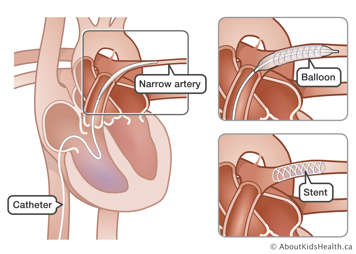What is a stent and when is it needed?
When part of a major blood vessel or conduit becomes narrowed (stenotic), blood cannot flow through it easily. A conduit is a tube that has been surgically implanted in some children to create a passageway for blood to flow.
A stent is a small metal tube made of stainless steel or another type of metal. It can be inserted into a blood vessel or conduit to help widen the narrowed passage by supporting the walls of the blood vessel to keep it open.
A stent is used:
- if the cardiologist feels that a balloon dilation (angioplasty) will not be enough to keep a blood vessel or conduit open
- if a dilation has not kept the vessel or conduit open

What is heart catheterization?
During heart catheterization, the doctor carefully puts a long, thin tube called a catheter into a vein or artery in your child's neck or groin. The groin is the area at the top of the leg. Then, the catheter is threaded through the vein or artery to your child's heart.
The doctor who does the procedure is a cardiologist, which means a doctor who works on the heart and blood vessels. This may not be your child's regular cardiologist.
To learn about heart catheterization, please see Heart catheterization: Getting ready for the procedure.
There are small risks of complications from the procedure
Generally, heart catheterization is a fairly low-risk procedure, but it is not risk-free. The doctor will explain the risks of heart catheterization to you in more detail before you give your consent for the procedure. The most common risks with stent insertion are as follows:
The catheter may break through a blood vessel
There is a very small risk that the catheter may break through a blood vessel or the heart wall. To reduce this risk, we use a type of X-ray called fluoroscopy to see where the catheter is at all times.
Complications may occur with the stent
Occasionally, the stent may be placed in the wrong position and a second stent needed. If a stent is in an unsafe position, it will be taken out, usually during catheterization. Surgery may be necessary in a few cases.
The opening may need to be made bigger at a later time, usually because it could not be fully widened during the first procedure. Less often, tissue grows into the inside of the stent, causing it to narrow again.
Your child will be given medicine to thin the blood so that blood clots will not form in the stent. Rarely, a clot may form anyway. If this happens, the clot can be dissolved with medicine.
For general information about the risks of heart catheterization, please see Heart catheterization: Getting ready for the procedure.
What happens during the procedure
The procedure is performed while your child is under a general anaesthetic. This means that your child will be asleep during the procedure.
When your child is asleep, the doctor threads a special catheter with a balloon and stent through your child's blood vessel to the narrowed area. The balloon is inflated. This forces the narrowed area open and expands the stent. The stent stays in place permanently to keep the vessel open.
Once the stent is in place, the doctor takes out the catheter and covers the cut on your child's leg with a bandage.
The procedure will take two to four hours
The procedure usually takes two to four hours. After the procedure, your child will go to the recovery room to wake up from the anesthetic. They will then be transferred to the inpatient unit.
After the procedure
Most children will spend the night in hospital after the procedure. The cardiologist will tell you when your child can go home.
For information on what to do after your child goes home, please see Heart catheterization: Caring for your child after the procedure.
Your child needs to take certain health precautions
Drugs to prevent blood clots
After your child comes home, they will need to take medicine to prevent blood clots from forming on the stent. Your child will take acetylsalicylic acid (ASA) or warfarin, which are medicines that thin the blood. The doctor or nurse will tell you how much ASA or warfarin to give your child before your child goes home.
Write the instructions and dose here:
If your child is taking ASA, stop giving the ASA and call your family doctor or paediatrician if:
- your child has a cold or fever
- your child is exposed to chickenpox
In general, you should give your child acetaminophen for fever and colds, as directed by your doctor. The doctor will tell you when you can start the ASA again.
If your child is taking warfarin, a special team called the thrombosis team will follow your child. Your child will need special blood tests and regular follow-up. You will be given detailed information to help you take care of your child.
If your child starts bruising easily, call your family doctor or paediatrician.
Do not change your child's medicines without talking to your doctor or a thrombosis team member.
Antibiotics to prevent infectious endocarditis
Depending on your child's specific heart condition, your child may need to take antibiotics before and after some dental and other procedures. These drugs help prevent a heart infection called infectious endocarditis. Speak to your cardiologist for more information.
Coming back for a check-up
Your child will be given an appointment to see the cardiologist three to six months after the stent placement. A catheterization will sometimes be booked for 12 months after the placement so that the doctor can examine the stent and see how well it is working.
Write the date and time of the appointment here: